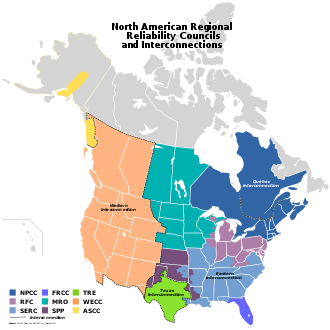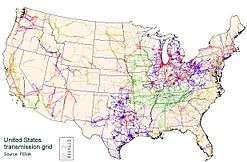Western Interconnection


The Western Interconnection is a wide area synchronous grid and one of the two major alternating current (AC) power grids in the continental U.S. power transmission grid. The other major wide area synchronous grid is the Eastern Interconnection. The three minor interconnections are the Québec Interconnection, the Texas Interconnection, and the Alaska Interconnection.
All of the electric utilities in the Western Interconnection are electrically tied together during normal system conditions and operate at a synchronized frequency of 60 Hz. The Western Interconnection stretches from Western Canada south to Baja California in Mexico, reaching eastward over the Rockies to the Great Plains.
Interconnections can be tied to each other via high-voltage direct current power transmission lines (DC ties) such as the north-south Pacific DC Intertie, or with variable-frequency transformers (VFTs), which permit a controlled flow of energy while also functionally isolating the independent AC frequencies of each side. There are six DC ties to the Eastern Interconnect in the US and one in Canada,[1] and there are proposals to add four additional ties.[2] It is not tied to the Alaska Interconnection.
On October 13, 2009, the Tres Amigas SuperStation was announced to connect the Eastern, Western and Texas Interconnections via three 5 GW superconductor links.[3] As of 2017, the project was reduced in scope and only related infrastructure was constructed for nearby wind projects connecting to the Western Interconnection.
Consumption
In 2015, WECC had an energy consumption of 883 TWh, roughly equally distributed between industrial, commercial and residential consumption. There was a summer peak demand of 150,700 MW and a winter peak demand (2014–15) of 126,200 MW.[4]
Production
The region had a Nameplate capacity of 265 GW in 2015. Natural gas provided 266 TWh at 29% capacity factor, coal made 217 TWh at 61% cf, hydropower made 197 TWh at 32% cf, nuclear made 60 TWh at 86% cf, wind power made 41 TWh at 21% cf, and solar made 18 TWh at 18% cf.[4]
See Also
References
- ↑
- ↑ Visualizing The U.S. Electric Grid
- ↑ High-Temp Superconductors To Connect Power Grids
- 1 2 2016 State of the Interconnection page 10-14 + 18-23. WECC, 2016. Archive